Not quite the victory they were hoping for
Type: Singleplayer, Multiplayer
Genre: Turnbased strategy, Wargame
Developer: Yobowargames
Publisher: Slitherine Ltd.
Release date: 17 Jun, 2021


Squad level tactical tabletop wargames set during World War II are nothing new. Squad Leader, Lock ‘n Load, Conflict of Heroes are just a few examples of games of this type, but there are many many more, like Valor & Victory, the subject of this review.
Valor & Victory was first released in 2007 as a free self-published print & play game. The files are up over on boardgamegeek.com for anyone interested in seeing the tabletop game. But this is not a review of the tabletop game, but the PC game made by Yobowargames, which is not free, but comes with everything we’ve come to expect from a PC adaptation of a tabletop wargame.
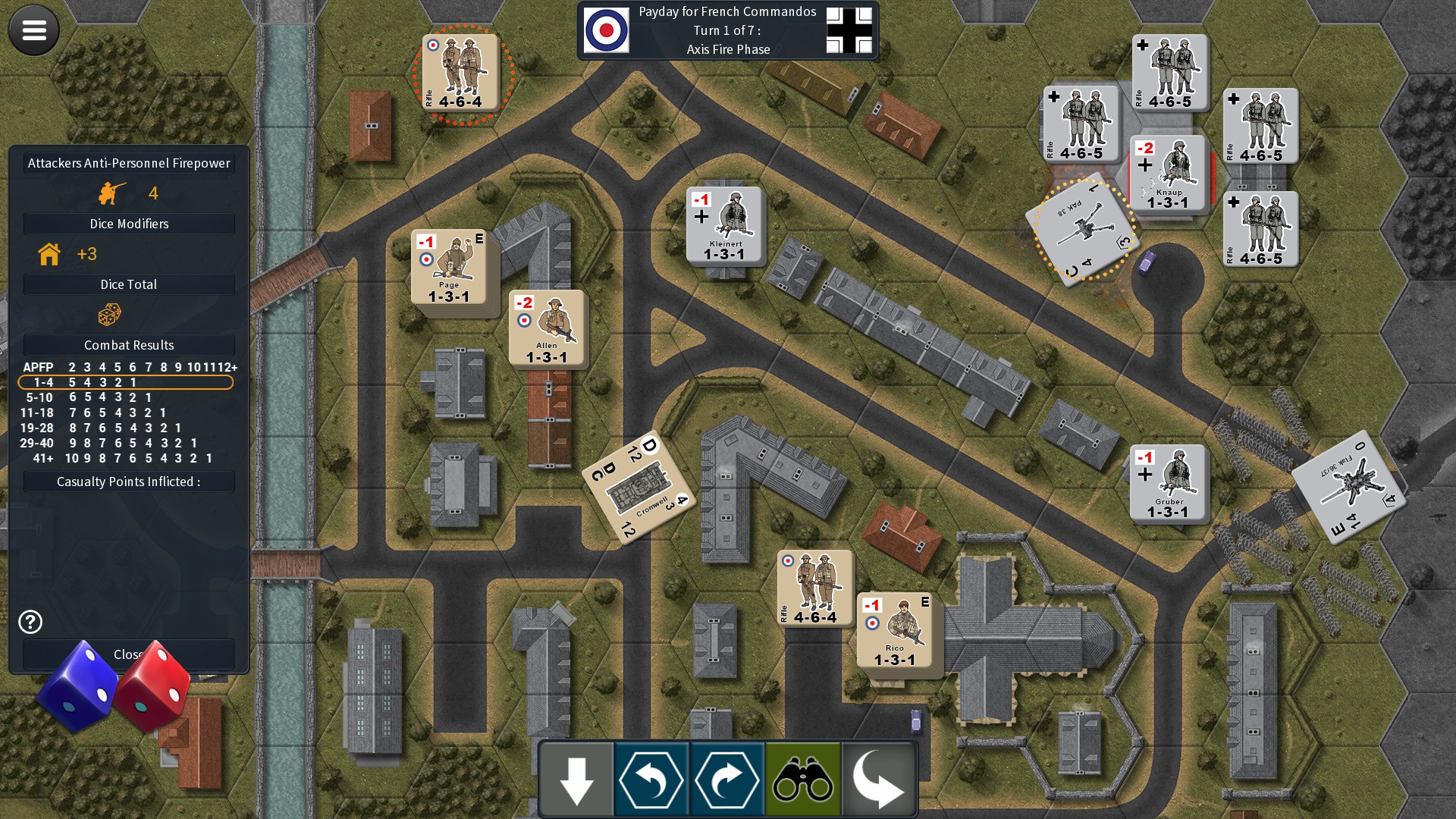
Story & Setting
Valor & Victory takes place shortly after D-day, and covers the fighting between the Germans and the allied forces. Fighting that historically the allied forces won. Some argue that this marks the point where it became clear that Germany were about to lose the war, though the actual importance of the D-day has been debated among historians, as Germany were already losing ground to the Soviet forces at this point. It probably did end up causing the war to end earlier than it otherwise would have, and the map of Europe would probably look quite different now had the Russians been the only ones really taking the fight to the enemy, but the war would have ended with a German defeat anyway.
Two allied nations are available, the US and the British, each of which has their own set of scenarios .Each scenario comes with a short writeup that explains what’s going on, and the importance of the engagement, but there’s no campaign that ties it all together, just 19 separate scenarios that are completely independent of each other. The writeup for each scenario is just a few sentences long, but adds some flavour to the game.
The three forces feel pretty accurately represented. At this point in the war, on a tactical level the US, UK and German forces were pretty similar, with similar equipment and training, and that’s represented in the game. They are not identical, but you don’t see any one side given equipment that’s massively better than the others. The area where they differ the most are with the vehicles, but even here the difference is not huge (unlike what History Channel “documentaries” would have you believe), and the things that do stick out tend to be some older vehicles, like the poor Matilda Mk.1. There’s one odd omissions when it comes to equipment though. There are no mortars or any other indirect fire weapons, something that all armies used quite extensively at this point in the war.
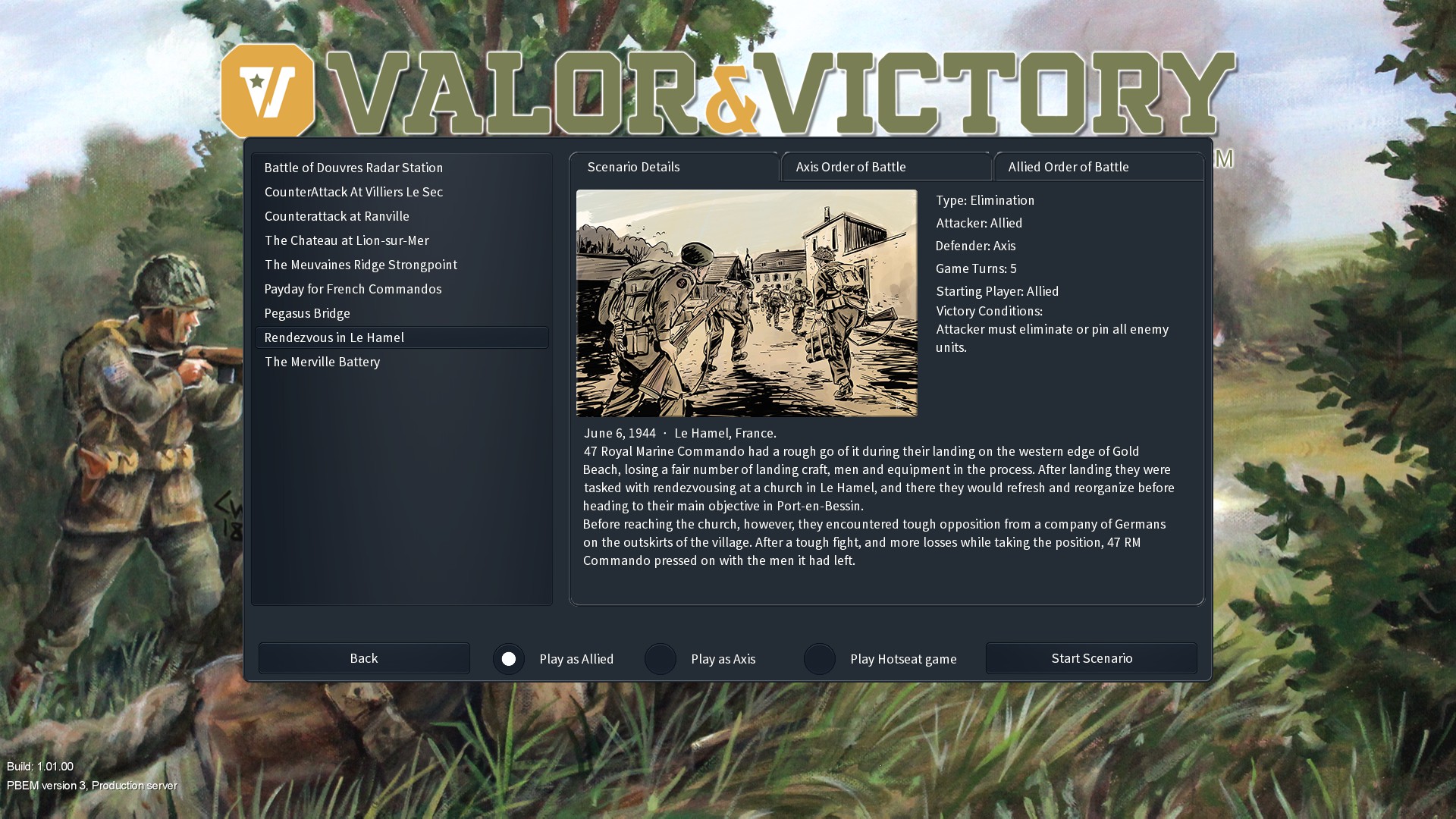
Presentation
This is a game based on a tabletop wargame, and it tries to capture the look and feel of that. Each map is made up of a hexagonal grid with terrain features dotted around them, seen from a top-down perspective. The maps themselves look pretty good, but are mostly static, apart from a few small visual flares, like smoke coming out of chimneys and birds flying past.
Units are represented by square counters with an image of what they’re supposed to represent on them, be it infantry, tanks or lighter vehicles, and they look just like what you would expect to find in a tabletop wargame. The images are static and pretty simple looking, but they’re easy to read at a glance, and they feel right for this kind of game. When units are attacking there are some simple effects. Bullets fly through the air, explosions can be seen on hexes hit by larger guns and so on.
The music is fine. There’s some pretty typical heroic songs, but it does not loop. Most of the time you’ll be listening to the sound effects played when units move or attack, and that’s it. Not that these sound effects are bad, by any means, they’re pretty decent, particularly for a game of this type. Other than that there’s a few ambient sound effects, like birds chirping, Some more music would have been nice during play, as without it the game can feel a bit empty.
As for the games interface, it’s overall pretty good. You can easily tell by just looking at a unit how strong it is, once you’ve learnt what the different numbers and letters mean. The game also does a good job at showing why your attacks connect or miss, with a remarkably intuitive chart. Mouse over a target and it will also show any defensive modifiers. It could use some more general terrain info though. It’s not hard to learn that a house gives a +3 defensive modifier, but when learning the game it would have been nice to be able to right-click on a piece of terrain to get the defense bonus, even if there’s nobody on that hex. Speaking of interface issues, there’s no way of viewing the objectives of a scenario once you’re in game. It is not hard to tell what your objectives are by looking around the map, as there’s a limited number of different victory conditions a scenario can have, but it would still have been nice to be able to quickly check the objectives without having to scroll around the map or go to the main menu.

Gameplay
Valor & Victory is a hex based tactics game about small scale combat. Each side has a handful of squads, exact number depending on the scenario, and the goal is usually for the attack to kill or pin all enemies, grab certain key locations or exit a number of units from the board. The defender then needs to prevent the attack from accomplishing their objectives.
Combat is turnbased and each turn is split into a number of phases, and the way this work is what sets Valor & Victory apart from other games of this kind. Each player does everything in order, and then the other player does their turn. A turn is split into five phases. The first, the command phase, lets you split and merge squads, move weapons and this is also where any pinned units get un-pinned. The fire is where you fire at the enemy, surprisingly enough, and every unit that is within range and line of sight of an enemy can fire. A unit that did not fire is then allowed to make a move, with different terrain costing different amounts of movement points. Move into line of sight of an enemy and they can use opportunity fire, which means that they’ll open fire on the unit that just moved. After that there’s the defensive fire phase, where every enemy unit that is within range and line of sight of an enemy, and that did not use their opportunity fire, is allowed to shoot, followed finally by the advance phase, where every friendly unit is allowed to move one hex, even through difficult terrain, or make an assault move against an enemy that’s adjacent to them.
A few things might have stood out there, chiefly among which is the fact that you fire and then move, and if you move into line of sight of an enemy, they can then fire at you. This is something that gives the defender a pretty big edge. To make matters worse for the attacker, the enemy is then allowed to fire again after their command phase, which means that any exposed units will get two rounds of fire thrown at them before they’re allowed to attack back. Units left out in the open, within range of an enemy, are in other words in big trouble.
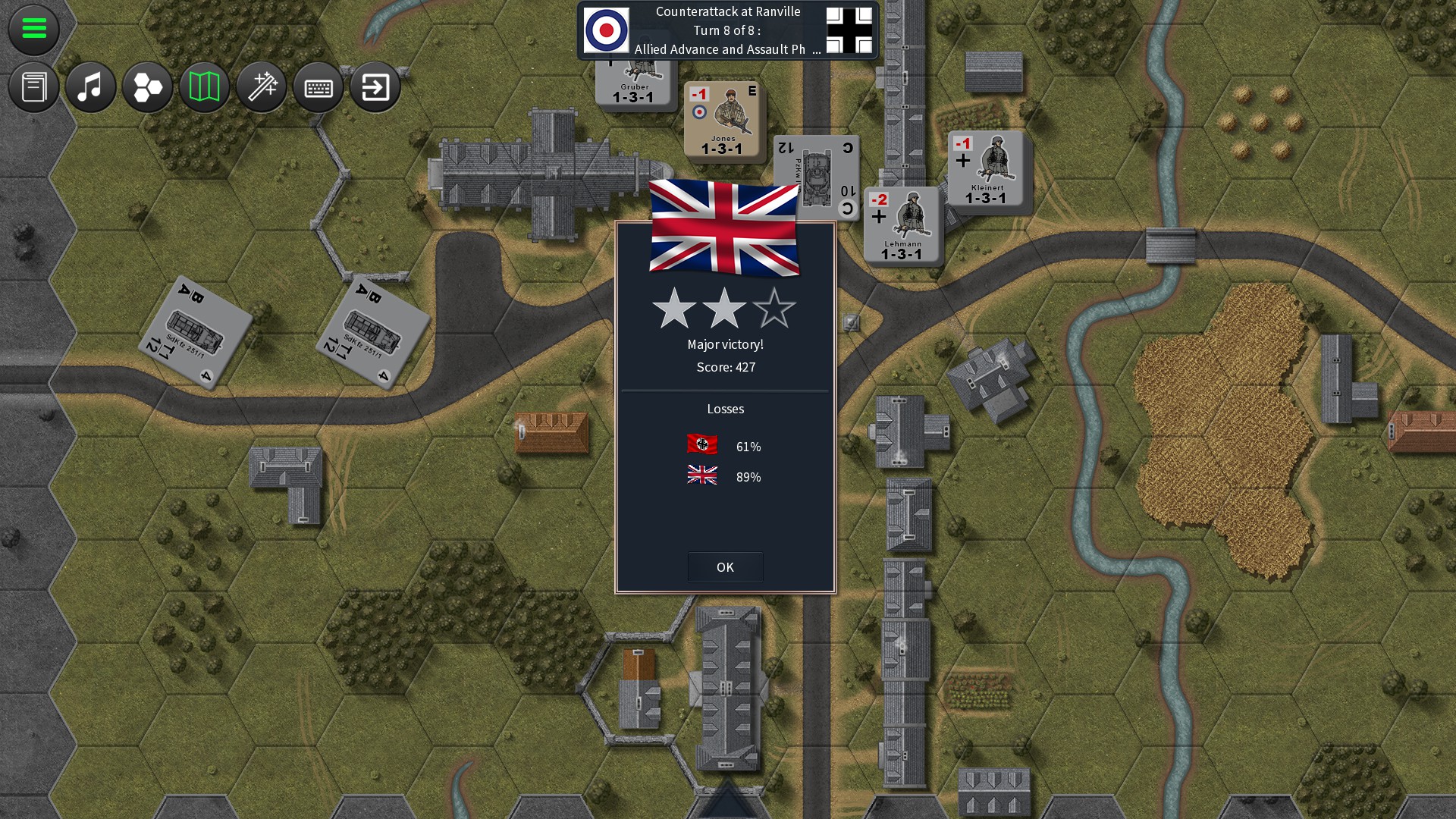
Attacking an enemy is straight forward. You chose what units in a stack wants to attack the enemy, add up the firepower of all friendly units in the same hex that are attacking the enemy and then you roll two 6-sided dice. A low roll is better than a high one, and your dice roll gets compared to a chart to determine the actual damage. Succeed by at least 2 and you’ll inflict damage, with every two points of success inflicting an additional point of damage, with a single point of success pinning an enemy. Terrain simply adds to this roll, so if the enemy is in a building you roll 2D6+3 (3 being the defensive modifier of a building), and friendly leaders in the same hex subtracts from the roll, based on their leadership value. All of this is handled automatically by the game, so all you really need to know is that lots of friendly firepower and a leader will improve your chances of hurting the enemy, and defensive terrain will make it harder to hurt them.
Opportunity fire is handled in a pretty weird way, and it’s not entirely clear (at least to me, who played through all the scenarios at least once) what the exact conditions are for triggering it. Opportunity fire is automatic, and the computer decides when it’s going to be used, which is, according to the manual, done to help play by email, which would otherwise be tedious if you had to go back & forth confirming opportunity fire, but there’s a lack of transparency here. Any form of machine gun (light or heavy) will also create a line from the attacker to the defender when using opportunity fire and anyone who moves through this line will get attacked, making machine guns really dangerous.
The luck factor in Valor & Victory is decently high. A good roll can make a big difference, though over the course of time luck tends to even out, and seen over a couple of games the better player should be winning most of the time. If anyone wants to run this in a tournament setting that’s worth keeping in mind though, as an individual game can quite easily be swung by someone’s dice being hot for a turn, as there are so few units on each side in most scenarios.
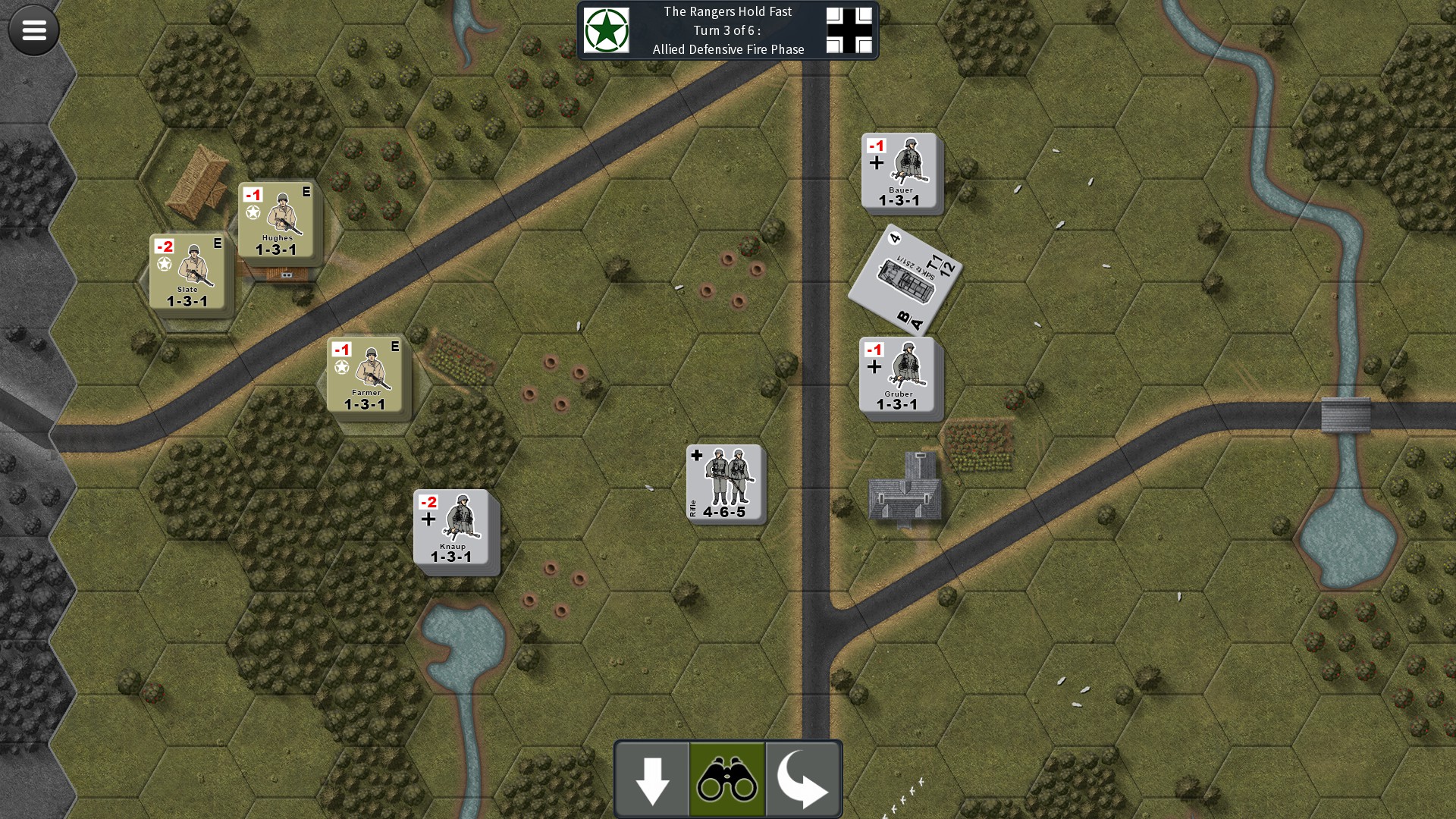
Speaking of scenarios, there are 19 of them, and they’re all pretty small. This is not a game about massive armies clashing on a battlefield, it’s about a few squads on each side facing off against each other, maybe with the support of a few armored vehicles. Every map is made out of one to two 17*9 hexes large “pieces” , and at the time of writing that’s the maximum size. The scenarios have varied setups with different unit compositions and terrain, and while there are a few that end up playing similarly, for the most part each scenario will give a different experience. Each scenario can be played from both sides, but the game defaults to always having the player play as the attacker.
There might be a reason why the player is always the attacker by the default, and that’s the AI. The AI is far stronger on the defense than on the offence, and playing as the defender is a bit akin to playing on easy mode (there are no difficulty settings in the game). The AI is not helpless when attacking, but it can be too timid and will often fail to make an attack even in the last turn, even if it must take that gamble in order to have even a chance of winning. While weak on the attack the AI does a good job on the defense and it’s good at tightening up its defenses if you managed to punch a hole in it somewhere. It’s not impossible to beat though, it just plays like you would expect a competent player to play.
Multiplayer is where this game is going to find its longevity. Play by Email is available, and with most scenarios being 5-7 turns long you could easily complete a PBEM game pretty fast. PBEM was not tested for this review though.
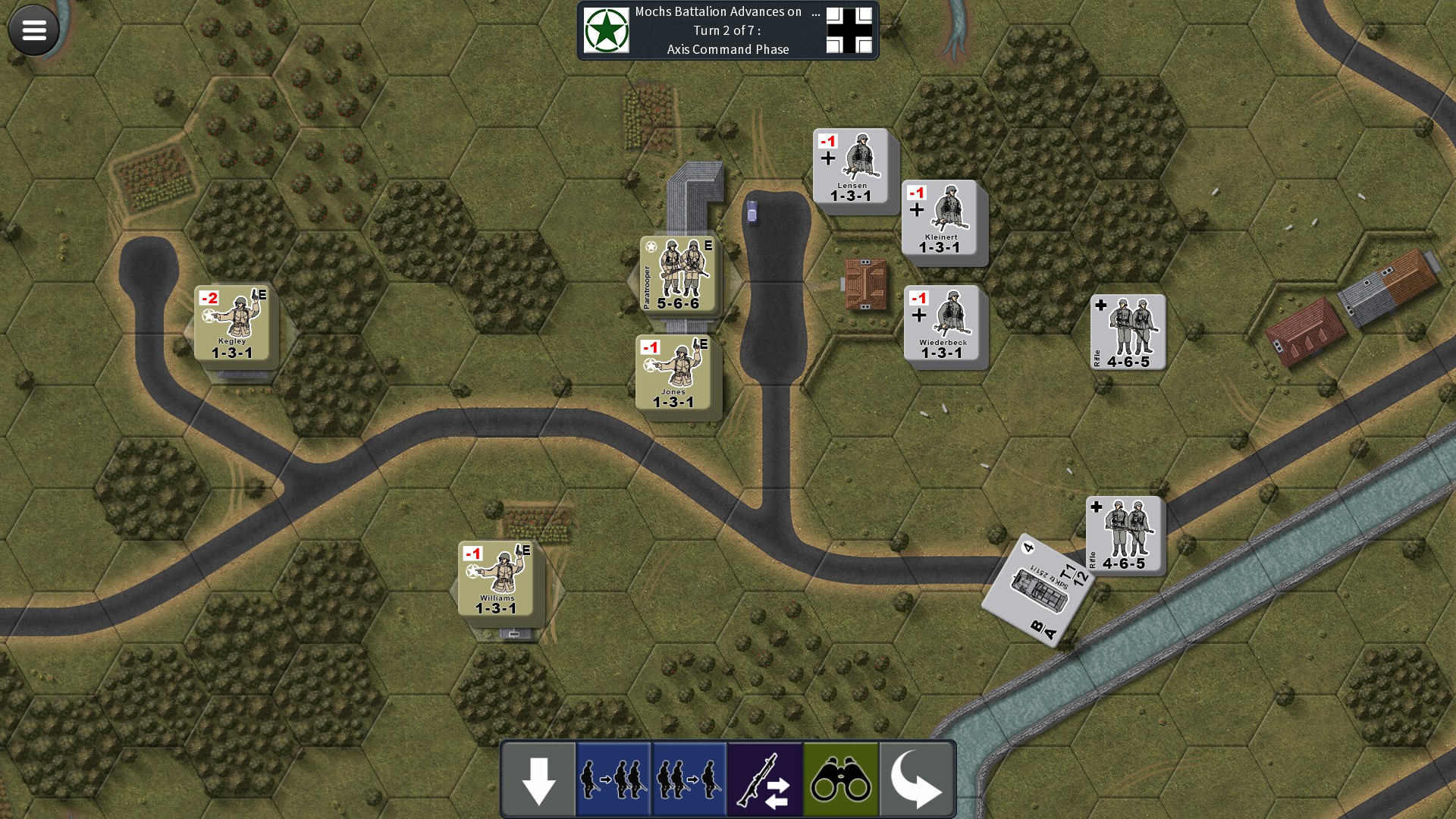
Mod Support
Valor & Victory comes with a very intuitive scenario editor. First you select a map from a limited pool of different ones, and then you can start placing units on the map. You can also chose between one of the three victory conditions, kill/pin all enemies, hold all objectives or exit the map with a certain number of units. It might not be the most powerful map editor out there, but it’s so easy to use that even someone who’s never touched a map editor before should have no problems making a scenario in it in next to no time. And if you think the game needs more maps with lots of tanks on it, you can very easily make a scenario like that (it would probably not be the most fun scenario in the world, as that’s not really what the game is built for, but it’s perfectly doable).
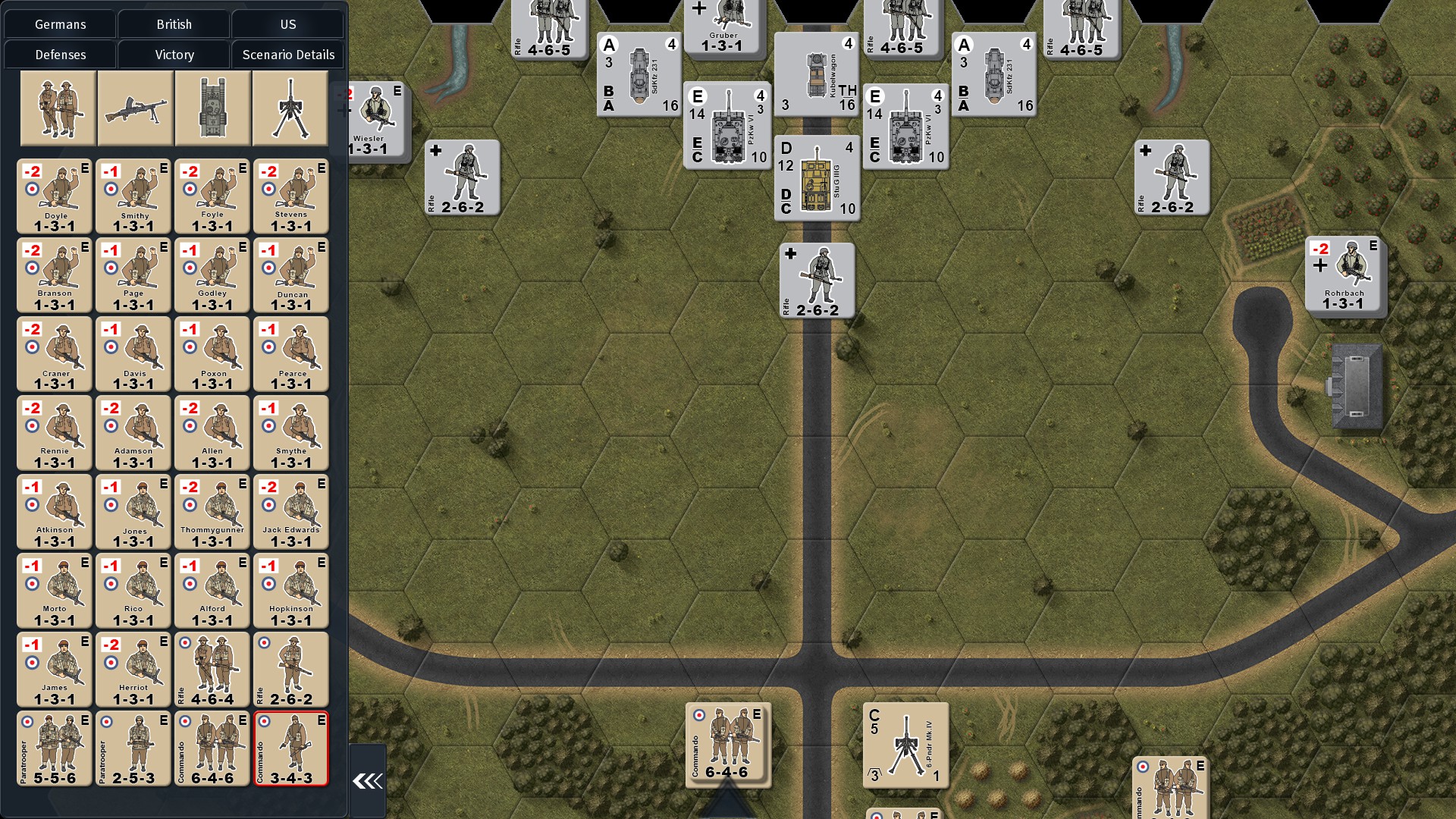
Closing Thoughts
Valor & Victory is a game with a strong foundation, but it fails to quite nail the execution. For being a game from a style that’s known for being pretty tough to get into Valor & Victory deserves praise for being so easy to learn and for being so straight forward. But there are a few blemishes on the game, the lack of any difficulty settings might make this too easy for veterans and too hard for newcomers to the genre and the unclear rules regarding overwatch makes it hard to plan around such things. There is probably a logic to when the game decides to use overwatch, but it’s never made clear in-game or in the manual. There are also a few small interface issues that makes it harder than necessary check certain things, like terrain bonuses and your objectives. The high luck factor might also be a turnoff for some. As you have so few units it’s pretty easy for games to become swingy. But luckily matches are short so if you do fail due to a few bad rolls replaying a mission does not take very long. If you keep failing because of “a few bad rolls” every time, then that’s probably on you though, and not your “bad luck”!










